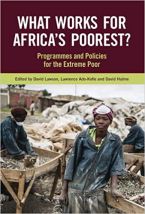What Works for Africa’s Poorest? Programmes and Policies for the Extreme Poor

What Works for Africa’s Poorest? is a collaborative work by Lawson, Ado-Kofie and Hulme, which highlights and learns from examples of development programmes in Africa, with specific attention to their effectiveness for the poorest of the poor. It brings together academics, practitioners and policymakers and highlights types of practical action that can complement the efforts of the poor. Specifically, this volume focuses on sub-Saharan Africa, and evaluates not only what works for the poorest in Africa but also why some policies and programmes do not work.
The volume comprises 16 chapters, organized into four sections: Parts A, B, C and D. In addition to the editors, 19 other authors contributed to the chapters. Part A identifies sub-Saharan Africa’s extreme poor and how to target them.
Here, Hulme and Lawson provide an introduction by discussing what works for Africa’s poorest (Chapter 1). This is followed by two chapters: on defining, targeting and reaching the very poor in Benin (Chapter 2); and on inclusive targeting and the experience of the Harmonized Social Cash Transfer programme in Zimbabwe (Chapter 3).
Part B turns to Africa’s children and youth. Ado-Kofie and Lawson emphasize how difficult surviving early childhood is for Africa’s extreme poor and therefore the importance of stronger health care systems, as well as addressing barriers that prevent the extreme poor from accessing them (Chapter 4). In Chapter 5, Roelen et al. evaluate the case of Cash for Care in Rwanda as a tool for improving social protection of children. Following on, Banks highlights the need to target Africa’s youth in development programmes, drawing upon the case study of BRAC’s Empowerment and Livelihoods for Adolescent Girls Programme in Uganda and Tanzania (Chapter 6; page 89).
Getting Africa to work is the topic of Part C. Chapter 7 begins with the case study of female engagement in commercial agriculture, interventions and welfare in Malawi. Chapter 8 then looks at food assistance in South Sudan by evaluating the effects of a food-for-training programme upon household labour supply, informal transfers, and welfare (page 123). The following chapter explores how public works can address poverty. The authors give an overview of three case studies of national programmes in Ethiopia, Rwanda and South Africa, which offer valuable lessons for conventional public works programmes. Finally, Chapter 10 looks at Tanzania’s Social Action Fund as a productive social safety net programme, and explores the potentials and limits of graduation for the extreme poor.
Part D concludes with thoughts on implementation and policy for poverty reduction amongst Africa’s poorest. Following on from previous chapters, it also focuses on social protection. The chapter by Holmes draws on the case of Nigeria. By discussing three sets of institutional and policy challenges to implementing social protection at scale, Holme identifies lessons and opportunities for future social protection initiatives (Chapter 12). Turning to conditionality cash transfer programmes in Chapter 13, Pellerano and Barca ask whether one size fits all, and present key criteria regarding “explicit” conditionalities in social transfers (page 223). Chapter 14 introduces the relevance of supply capacity to social safety nets, with an emphasis on cash transfers. Then in Chapter 15, Dubin and Lawson discuss access to justice for the very poorest and marginalized in Uganda, and highlight the need to integrate justice policies into broader pro-poor programming (page 255).
To end, Hulme, Lawson and Ado-Kofie provide a conclusion in Chapter 16 by reviewing key points and lessons from preceding chapters. They emphasize that the evidence highlights a need for outrage at the lack of structural change in many African states and in international relations, but also for tempered optimism stemming from innovation and learning that can improve the prospects of Africa’s poorest (page 268). Hulme et al. highlight the importance of context-specific poverty reduction programmes and of adapting lessons sensitively at both the national and sub-national levels. Although they concede that economic, political and structural constraints limit progress to reaching the extreme poor in Africa, they assert that these do not stymie human agency, which can evolve into “forces that eventually tackle the over-arching structural constraints” (page 269).
Book note prepared by Hannah Keren Lee
Search the Book notes database
Our Book notes database contains details and summaries of all the publications included in Book notes since 1993 - with details on how to obtain/download.
Use the search form above, or visit the Book notes landing page for more options and latest content.
For a searchable database for papers in Environment and Urbanization, go to http://eau.sagepub.com/

